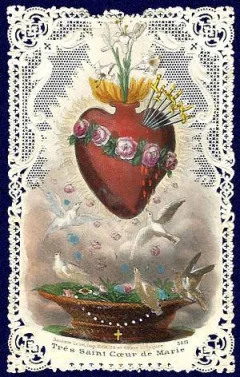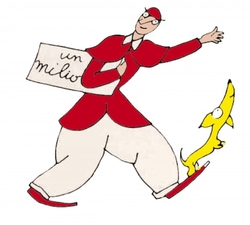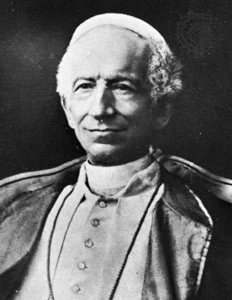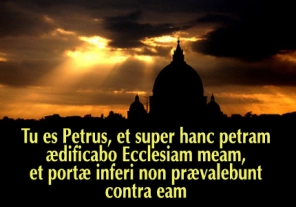They Can’t Be Both Right
After the events of the last days, it might be good to refresh an elementary principle of logic that is, if you ask me, all too often forgotten: the principle of non-contradiction. The principle states that contradictory principles cannot be true in the same sense at the same time. It seems obvious, and it is, but one would be surprised at reflecting how often it is neglected.
Pope Francis, as we all know, refused to wear the Mozzetta and the golden cross. His new attitude found, we are informed, many friends among Catholics, to whom “simplicity” is suddenly so appealing, particularly now that a phenomenon completely unknown during the history of the Papacy (I am obviously referring to the poor) has appeared. Perhaps we should stop a moment and reflect on what is happening here.
As you all know, Catholicism is very rich in symbolism. It is, in fact, so densely populated with it, that a typical trait of Protestant denominations is either the toning down or the outright abandonment of the extremely rich Catholic traditions.
The sedia gestatoria wasn't the way the Church prevented a Pope from muddling his shoes. The Tiara wasn't conceived so that he Had to keep his head straight. The ermine Mozzetta isn't there because Popes are old and need to keep warm. They are symbols of Papal authority, a sensorial way (visual, in this case) to remind one in a simple but effective manner of a supernatural reality. Of course, it is not the Tiara that count, it's the Papacy; but every attack to the symbols of power symbolises, nay, it literally invites, a weakening of this power.
In past ages, everyone understood this, and this symbolism found application everywhere. When Kings had real power, they had real crowns, and real sceptres, symbolising their position; symbols of power whose use in real life has almost disappeared, together with their power. Similarly, when Priests wanted to be recognised as such they wore a cassock; when they started to be “one of us”, they started to wear priestly suits; and when they started to be ashamed of being priests, they started to wear plain clothes. You can think of further thirty examples of this elementary logic for yourselves. Symbols are powerful.
Some of the symbols of Papal authority are now – if we are honest with ourselves – under attack. After the sedia gestatoria and the mitra, the Mozzetta, golden cross and red shoes are now supposed to go. Make no mistake, this attack to the symbols of the Papacy is, whether willingly or not, a weakening and banalisation of the majesty of the Petrine Office.
Which leads us nicely to the initial argument: this abandonment of the traditional symbolism of the Papacy can find you in agreement or not, but not both at the same time.
It can't be that Benedict was right in recovering aspects of Catholic tradition, and Francis is right in demolishing them. One of them must be wrong, because they are at opposite poles of the way to understand the art the Papacy must be perceived. Again, this here is not about not liking red shoes, or thinking the Mozzetta is too warm; it is about wanting that the authority of the Papacy is clearly, immediately, unmistakably perceived. This desire, cultivated for centuries and so very typical of Catholicism, cannot be right and wrong at the same time. You either are with with Benedict and his predecessors, or with Francis.
Why, then, so many commenters around many blogs, who were all in favour of Benedict's red shoes, are now enthusiastic fans of Francis' black ones? Because they aren't thinking, they are merely emoting; which latter also avoids the embarrassment of having to think “the Pope is wrong”, apparently a taboo among so many that I begin to think the Protestant mockery of “Papolatry” certainly applies to a good many simple Catholics.
Imagine a new, young queen appearing in low-cut jeans and t-shirt, and the crowd saying “how beautiful! How simple! How humble! So long, useless pomp of the past! She is one of us, why shouldn't she dress like one of us?”. The answer obviously is that she shouldn't, because she isn't. But if she starts to dress like one, at some point she'll certainly be.
Thinking of which, why is the red Mozzetta not in order, but the white cassock is? Why should the “bishop of Rome” not dress like every other bishop? Everyone knows he is the Pope, right? And why a cassock? How many priests wear cassocks? Would not be more “humble” and “simple” to wear a simple priestly suit? What about trousers and sweaters? Why not jeans? He is one of us, right?
So long, shoes! Welcome, sandals!
“But, no, Mundabor, he isn't! He is the Pope! Successor of Peter! Vicar of Christ!”.
Exactly. He is the Pope, Successor of Peter and Vicar of Christ, and out of respect for the Holy Office with which he was entrusted he should have the humility to dress accordingly and appropriately, whether he likes it or not.
I'd say this respect for one's office is fitting for everyone, but most of all for a Pope.
Mundabor
Posted on March 17, 2013, in Catholicism and tagged Conservative, Conservative Catholic, conservative catholicism, Mozzetta, Pope Benedict, Pope Fra, Pope Francis. Bookmark the permalink. 12 Comments.





















Pretty much what my hubby said this morning at breakfast. We were talking more about his penchant for wading out into the crowds because he was “just one of the people.” I’m quite certain that his security staff is, as Father Z likes to say, “having a spittle flecked nutty.” It is clear that Pope Francis is strong-willed and has decided to do exactly as he pleases no matter what advice he may have been given. That is the opposite of humble.
The fact is, he is not just “one of the people.” He is the Holy Father and he is inviting some crazy to take a pot shot at him which endangers the security staff and the crowds. That reason alone should be sufficient for him to practice a bit of prudence.
I like your husband.. 😉
Yes, humbleness would make one follow what all Popes before him have done. Francis wants to have it his way at all costs. Not very humble, I’d say.
M
Cardinal O Malley of Boston who is a Franciscan is known for having his sandals made for him and they cost a mint. All this fake humility is making me nauseous.
But I am sure they are not red, so everyone is satisfied.. 😉
M
They can’t be both right? Indeed. But must they be opposed? I don’t remember Benedict’s choice of red shoes being interpreted as a criticism of John Paul’s choice of brown shoes.
Journalists are looking for conflict. They thrive on a hermeneutic of rupture. But I don’t see why any of us should accept that hermeneutic.
Now having said all that, I think you’re right about true humility. Matthew Crawley and all that. Perhaps Francis will get some red shoes once the black shoes wear out.
Dear Father,
Journalists may be looking for conflict, but this is not like preferring strawberries to vanilla. There is an ideology behind, and yes, both ideologies can’t be right.
M
“It can’t be that Benedict was right in recovering aspects of Catholic tradition, and Francis is right in demolishing them. One of them must be wrong, because they are at opposite poles of the way to understand the art the Papacy must be perceived. Again, this here is not about not liking red shoes, or thinking the Mozzetta is too warm; it is about wanting that the authority of the Papacy is clearly, immediately, unmistakably perceived.”
Is it possible, though, that you may be mistaking symbols of the wordly power of the former princely papacy for symbols of the papacy at its essence? The Papal States are a thing of the past. Granted, the Vatican City State remains but that’s more or less a legal fiction devised to give the Bishop of Rome independence; it doesn’t exist as a means for the Pope to recapture his glory days of the past in terms of temporal power.
Items like red shoes and ermine and the tiara actually have nothing to do with the Pope’s role as chief shepherd of Christ’s flock, rather they all point toward a papacy embellished by temporal authority that no longer obtains and, which, it may be justly argued, never ought to have come about in the first place. Between that worldy vision of the papacy and Peter’s papacy, for example, it may be argued there obtained a clear hermeneutic of rupture.
If Benedict restored items hearkening back to a former reality, items which his predecessors put aside, were his predecessors in error for putting them aside in recognition of today’s reality, or was Benedict perhaps misguided in reintroducing them in an era and paradigm in which they are foreign and anachronistic?
While clearly returning to the archives most of the outward signs of the former royal papacy, Pope Francis has maintained the traditional white cassock of the Bishop of Rome, and other symbols of the Pope’s essential role as shepherd of the flock, such as the Fisherman’s ring, the pectoral cross, the zucchetto, the pallium, and the pastoral staff. That is the correct image of the papacy to project in the year 2013, when the Pope means to newly evangelize the world…a world that no longer respects the papal trappings that emerged during an era when the papacy was the plaything of corrupt and greed-driven Italian aristocratic families engaged in endless temporal power struggles.
That’s my take on things, in any event. Now…why Francis seems to have abandoned the mozzetta altogether (even the simple, satin version) and the rochet is anybody’s guess. That’s the only thing that doesn’t seem to make sense, although I suspect that, had they supplied him with the simple mozzetta to begin with (which they did not), he would have worn it and this mozzetta curfuffle would never have transpired. I fault whomever is responsible for omitting the satin mozzetta (traditional for first balcony appearances of new popes) from the rack in the Room of Tears for all this needless controversy.
James,
it is simply not true that the exterior pomp of the Church reflects the wordly power of the Church as seen in the papal States.
On the contrary, the kingship of Pope is a spiritual, not a territorial one. The ermine & Co. of the Church remind us of this kingship, and the triple crown called the Tiara reflects the authority of the Pope over every temporal ruler in spiritual matters.
As to the former Popes, of course the post V II Popes were tragically wrong in downplaying the kingship of the Pope. All V II Popes have been masters in self-castration, irresponsibly renouncing to exercise a power which is, even today, without equal on the planet.
The symbols that have remained – how long, is anyone’s guess – are there for the simple reason that they are not assertive – as a Tiara would – of the fact that the Pope demands that his kingship be acknowledged and, so to speak, concretely and physically perceived.
The abandonment of the Mozzetta follows this same pattern: it is a divestment of authority. This is the same mentality followed by all post V II Pope, only this time it is worse…
I also do not think it is a matter of satin or ermine. Pope Francis has had many occasions to wear a simpler Mozzetta (general audiences, for example) and up to now does not seem (from the photos I have seen) to have adopted the habit. But truly, the winter Mozzetta has the ermine, and it was cold in March, thus the winter Mozzetta was the proper Papal attire. Still, I can’t imagine if he had said “give me the lighter one”, one wouldn’t have been found.
But the point which, it seems to me, escapes you is a different one: the Pope is every bit a King now as he was in the past. It is his role as a Pope which demands that it be so. Pope Francis has rejected the outer manifestation of this power, which cannot lead to anything else than a weakening of the perception of the real role of a Pope, reduced to a harmless “pastor” rather than one who can demand obedience from kings; which your very comment abundantly proves.
M
I feel as if we’re coming from two irreconcilably different perspectives but I’ll take a stab at some of your points.
“it is simply not true that the exterior pomp of the Church reflects the wordly power of the Church as seen in the papal States.”
The splendor of the liturgy, which does, properly, reflect the Church in her relationship to God (and vice versa) isn’t the same, of course, as the pomp (an entirely appropriate word) of the Papal Court, and that pomp only developed in response to the Pope’s acquisition of temporal power and prerogatives. None of the courtly pomp of the papacy (again, distinct from liturgical solemnity) speaks to the essence of the role of the Holy Father, however, which is to shepherd the flock in the place of Jesus Christ (who vested himself with no worldly pomp, or even liturgical solemnity, for that matter).
“On the contrary, the kingship of Pope is a spiritual, not a territorial one. The ermine & Co. of the Church remind us of this kingship, and the triple crown called the Tiara reflects the authority of the Pope over every temporal ruler in spiritual matters.”
The Pope’s office, in it’s essence, makes no claim to kingship but of service. It assumed the role of temporal kingship in the wake of imperial absence in the West, but that was accidental, not essential, not inherent to the office. That temporal power that the Pope assumed in the absence of imperial power has long since vanished, rulership of the temporal order properly belonging to the state, and not to the Church. The tiara emerged in days when the popes were beginning to flex their temporal power and when kings were beginning to wear imperial crowns. Only much later in the game were pious re-interpretations of the meaning of the tiara forced upon it.
I don’t agree that the abandonment of the papal mozzetta and rochet (for now, at any rate) constitutes the continuation of any sort of a pattern. It seems completely peculiar to Pope Francis, and I fully expect that it will return, perhaps even during Francis’ own pontificate. It may be that, since the mozzetta and rochet properly constitute “choir” dress, Pope Francis sees no logic in wearing it outside of situations that properly call for choir dress. It’s a guess on my part, I’ll grant you, but it seems a reasonable one when we notice that he only dons the pastoral stole when the moment requires it, removing it as soon as the moment has passed (while reverently kissing it).
” Still, I can’t imagine if he had said “give me the lighter one”, one wouldn’t have been found.”
But it wasn’t provided in the Room of Tears (that much is known for certain), and just before he walked out onto the balcony, it’s highly unlikely that he would have said, “I’ll wait here while one of you runs over to the Apostolic Palace (which would have taken a long time) to grab one out of Pope Benedict’s wardrobe.” Pope Benedict may even have packed his away for all anybody knows. But it’s easy to understand why Francis would have said no to the ermine. It certainly would have projected an image of a former reality. Again, I believe it was Pope Benedict’s mistake to reintroduce the ermine mozzetta, not Francis’ to decline it.
In any event, regardless of the time of year, the satin mozzetta is traditionally worn by the Pope at his first balcony appearance, not the Winter mozzetta, not the Paschal mozzetta. And there is a reason for that. The satin mozzetta is the mozzetta that correctly corresponds to the choir mozzettas of other bishops, and before his balcony appearance, the pope is dressed in his choir attire, as are all the cardinals while in the Sistine Chapel. The ermine mozzettas are more correctly statewear, as opposed to choir dress. Were Pope Francis to have appeared on the loggia in the Winter mozzetta (of state) that was (incorrectly) provided, that would also have represented a break with custom.
Again, the fault lies with whomever attempted to force the new pope into wearing the Winter mozzetta by not providing the correct satin mozzetta for his use in the Room of Tears.
“Pope Francis has rejected the outer manifestation of this power, which cannot lead to anything else than a weakening of the perception of the real role of a Pope, reduced to a harmless “pastor” rather than one who can demand obedience from kings…”
What kings? Surely you don’t suppose that if the Pope were to don all of his Rennaissance era costumes it would compel civil authorities in the 21st century to submit to his spiritual authority. As far as his temporal authority, he hasn’t got any, except within Vatican City. It seems, if I may say, that you are arguing many of your points of view as if from a bygone era…from a former reality that no longer exists.
At any rate, thank you for permitting me to participate on your blog and for engaging my remarks. Pax tecum.
You write too long messages, but this time I let it pass to show to my reader that at times it can only be simply disinformation.
You are simply wrong on the kingship of the Pope, and all your mistakes come from there.
The continuation of the abandonment of Papal power is just a further step in a process started a long time ago: Pope Paul VI wore the tiara only by his inauguration; John Paul I not even then; no one ever uses the sedia gestatoria anymore; Popes go to rock concerts, and organise interfaith meetings; it’s a long list…
As to the Mozzetta, I was informed he might have refused to have the ermine; but whatever it was, Marini surely had the right one.
The Pope must compel the civil authorities of the XXI (and XXII, and XXIII…) century to submit to his spiritual authority, period.
M
“You write too long messages…”
My. I’m glad, in that case, that I didn’t mention anything about the serge papal mozzetta for funerals or the cloth papal mozzetta worn during lent that Pope Benedict didn’t see fit to revive. Really…if we want to be absolutely traditional (and it seems we do)…If Marini didn’t provide the simple Lenten cloth mozzetta, he certainly didn’t provide the right one. I won’t even mention that all the rochets provided for the new pope were positively dripping in lace, traditionally speaking a no-no during Lent (at least according to the SSPX seminary I attended).
I think Marini knows more than both of us together. I doubt Pope Ratzinger would have followed him all the way to traditionalism. As in everything, Benedict was a gradualist and, alas, a son of V II.
No tiara, no sedia gestatoria, no showing of Papal teeth.
Still, compared to Francis he was a real traddie
M